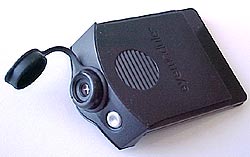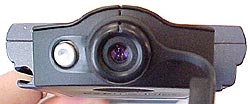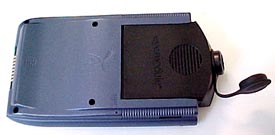EyeModule 2 Digital Camera Review
 One of the downsides of the Handspring is that while it is
a great portable notepad, there is no built-in way to take a quick picture. The
Eyemodule 2 is designed to fill this void and does so quite well by our
impressions.
One of the downsides of the Handspring is that while it is
a great portable notepad, there is no built-in way to take a quick picture. The
Eyemodule 2 is designed to fill this void and does so quite well by our
impressions.
Based upon the Springboard expansion platform, the
module sits flush to the back of the Visor and enables a user to capture colour
images of up to 640x480 resolution while on the go with just the click of a
button.
The unit,
which costs about $200 USD is made by Blocks Products, the manufacturing arm of
IDEO. IDEO are a fairly well known design firm which are responsible for the look of
the unit itself. The design, and in fact the unit itself
is very simple to use - there is only a button and a
lens so the choices are obvious.
To use
the Eyemodule 2, the user need only insert it into the Springboard expansion port of an awaiting
Visor. The device draws both battery power and storage memory from the parent Visor.
In a typical configuration the Visor will be able to store
about (50) 640x480 resolution images, (150) palm-sized 160x120 resolution
images, or just over 20 seconds of quick time mini-movies. The images are
stored as JPEG's and offer fairly reasonable picture quality considering the lens
size.

The lens
and VGA CMOS sensor are made by Agilent Technologies. The lens has a focal
distance of 18" to infinity, and
an angle of view of about 52 degrees. With a focal length of 6mm,
F2.8 the camera can take reasonable images in moderate to low light environments - lighting controls
are limited to low-normal-high settings. Images are captured by
pressing a button on the front of the unit, which are then displayed on the
screen for storage or disposal. The Palm-sized images in particular are quite small but have the
best overall image quality. The full sized images are a more useful
size, but have a slightly granular look to them.


